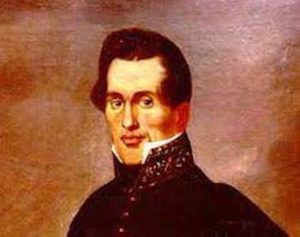
Lawrence Taliafero
*Lawrence Taliaferro was born on this date in 1794. He was a white-American Army officer, Indian agent, and enslaver.
Lawrence Taliaferro was born at Whitehall Plantation in King George County, Virginia, to James Garnett Taliaferro and his wife Wilhelmina (Wishart) Taliaferro. During the War of 1812, he enlisted at age 18 as a volunteer in a Virginia militia company. He studied for a Regular Army commission and ensigned the 1st United States Infantry Regiment in July 1813. He chose to remain in the Army as a career after the war.
Taliaferro partnered with Colonel Josiah Snelling to ensure peace and safety for whites at the frontier outpost. Taliaferro had previously served with Josiah Snelling at the battle of Fort Erie in the War of 1812. They were close friends as well as professional allies. His role was to mediate between the American Fur Company traders, the indigenous Ojibwa and Dakota Indians in the area, and United States interests.
This was a difficult task, as evidenced by his diary: "How to get rid of me at this Post seems now the main object of Tom, Dick, and Harry so that those who may come after me can the more easily be bribed or threatened into silence and acquiesce in the plans on foot to cheat & destroy the Indians."
Taliaferro encouraged the Dakota to rely less on hunting and farming to respond to their difficulties in hunting at that time. However, most Dakota people were unwilling to do so, as they considered farming the way of the white men. Chief Little Crow once told Taliaferro there was "no sugar in your mouth." for his honesty and his record of not making promises that he could not keep.
Taliaferro built a council house just west of the fort in 1823, where he received Indian visitors and mediated in the area's affairs. Both the Dakota and the Ojibwa would travel along the Minnesota and Mississippi Rivers to the fort to seek advice and ask for charity and favors. A colleague, Colonel Zachary Taylor, assumed command of the fort in 1828. He observed that the "buffalo are entirely gone through white slaughter, and bear and deer are scarcely seen." He also wrote that the "Indians subsist principally on fish, waterfowl, and wild rice."
Taliaferro applied his influence by carefully distributing food, gunpowder, tobacco, and whiskey to the tribes. The agency's blacksmith was also on hand to repair Indians' guns and traps. Indians relied on these supplies and services, and since those services could be stopped at any time, this promoted enabling and peaceful relations between the whites and Native communities involved.
Taliaferro presided over the drafting of a treaty in 1837. He brought Dakota leaders to Washington, D.C., and negotiated what he thought were fair terms for Dakota lands east of the Mississippi River. The United States government did not keep up its end of the bargain. The Indians ended up debt-ridden and desperate for their means of survival, and Taliaferro became increasingly critical of the United States' inability to make good on their promises. In poor health, he resigned from his position and left the Army.
Taliaferro was the owner of at least 21 enslaved people. One of them, a servant named Harriet Robinson, married Dred Scott. As Justice of the Peace in the territories, Taliaferro officiated the marriage of Scott and Robinson, which many historians believe gave additional credence to the Scotts' claim to freedom. Taliaferro gave Harriet to Scott's master so the couple could live together as husband and wife. Lawrence Taliaferro, best known for his service as an Indian agent at Fort Snelling, Minnesota, from 1820 through 1839, died on January 22, 1871.